MARIANI’S
Virtual Gourmet
April 30,
2017
NEWSLETTER

Orange
Brewery truck, Orange, NJ, circa 1916
IN THIS ISSUE
TWO CLASSIC FINGER LAKES TOWNS
By John Mariani
NEW YORK CORNER
UNION SQUARE CAFE
By John Mariani
NOTES FROM THE WINE CELLAR
WHAT I'M DRINKING NOW
By John Mariani
❖❖❖
TWO CLASSIC
FINGER LAKES TOWNS
By John Mariani
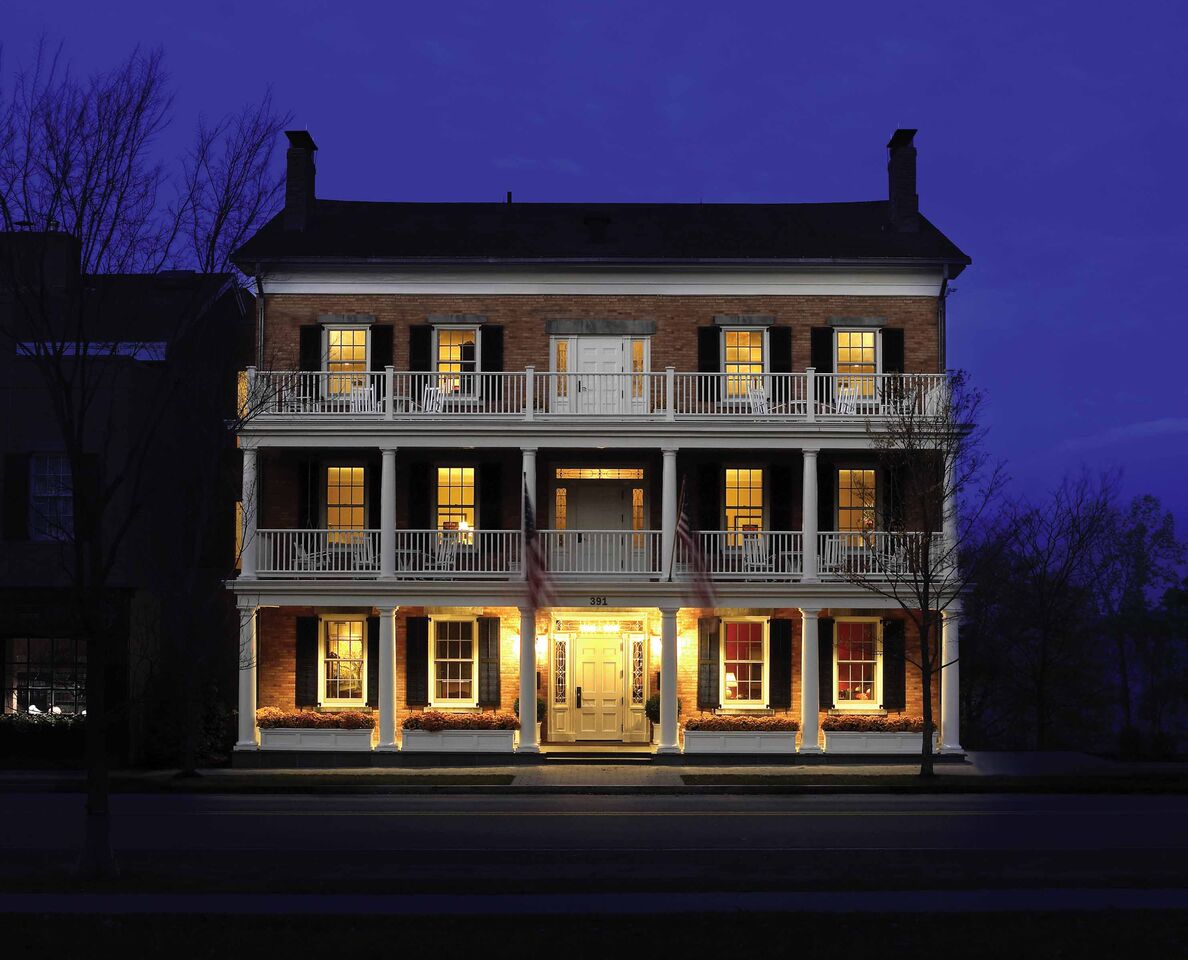
The Aurora Inn, Aurora, NY
I
suspect that most people who have visited only
New York City have little idea of the vast size
and diversity of New York State, which stretches
from the tip of Long Island to the Canadian
border and from Vermont to the western end of
Pennsylvania, bisected by the Hudson River and
anchored by Niagara Falls.  And one of the most
beautiful and most visited regions of New York
is the Finger Lakes, eleven of them, spread
through the middle of the state and lined with
some of the loveliest small towns in the nation,
including Skaneateles and Aurora.
And one of the most
beautiful and most visited regions of New York
is the Finger Lakes, eleven of them, spread
through the middle of the state and lined with
some of the loveliest small towns in the nation,
including Skaneateles and Aurora.
Set on a lake of the same name, Skaneateles (Skan-ee-AT-eh-less)—Iroquois for “long lake”— is both a town and an historic village, dating back to 1794, along what became known as the Seneca Turnpike. By the middle of the 19th century the community had attracted wealthy entrepreneurs who outdid each other building mansions along the water, some still extant and in perfect condition, like the Richard DeZong House (1839) and the Reuel E. Smith House (1852), within the Historic District. At Christmastime the village holds a Dickens Christmas, with actors in period costumes entertaining on the street.
Two of the area’s best hotels are in Skaneateles.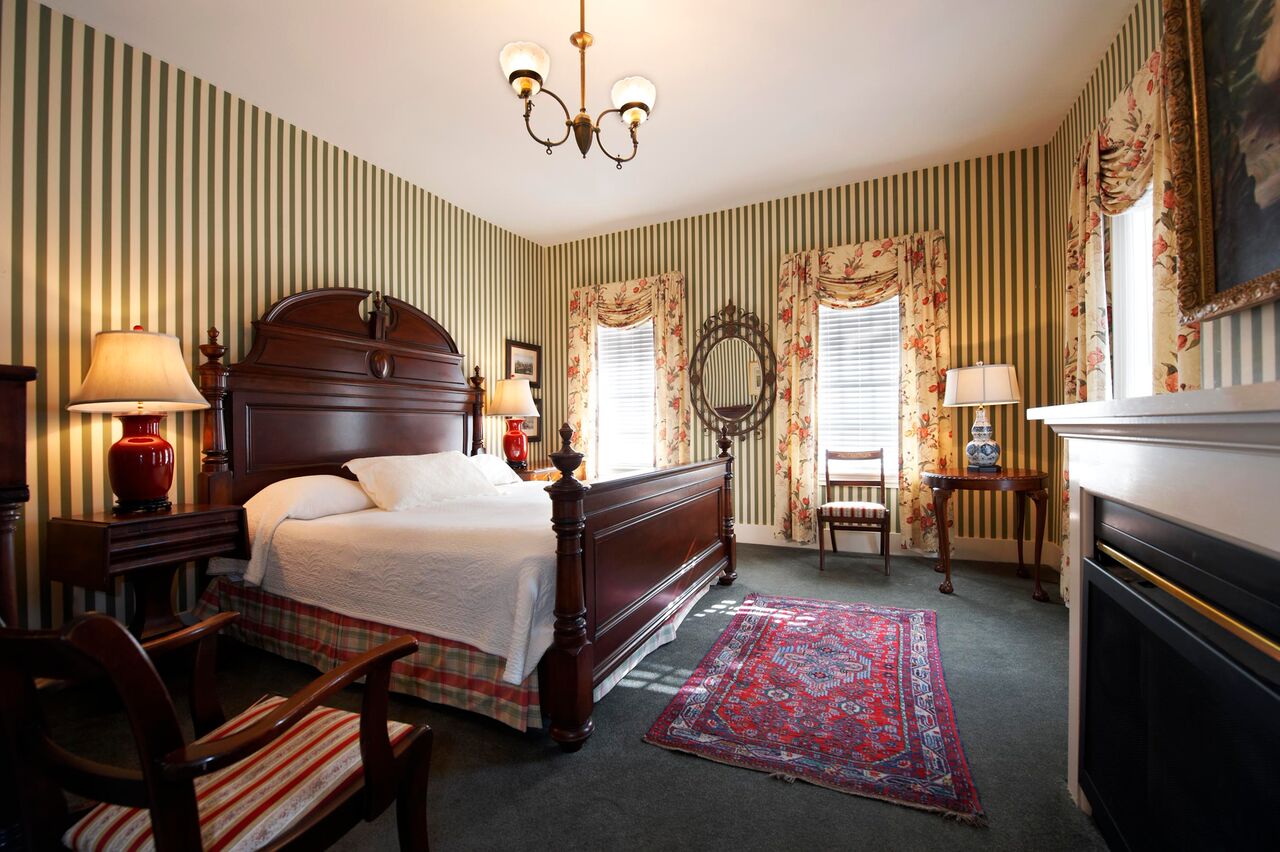
The Sherwood Inn (right) sits right on the main road, West Genesee, dating back to 1808 and built by Isaac Sherwood as a tavern to service his stagecoach business. Successive owners expanded the premises—it once served as a hospital during the 1918 influenza pandemic—and it is currently owned by William B. Eberhardt. There are now 25 rooms and suites, none like another, all decked out in period antiques, some with canopy beds, fireplaces and Jacuzzis.
There
is a lakeview porch overlooking the street (which
unfortunately gets an inordinate amount of loud
truck traffic), a casual tavern with a seafood raw
bar, and an elegant main dining room done in dark
woods and serving seasonal American cuisine, which
usually includes Yankee pot roast and baked
scrod—the onion soup is very good—backed by a fine
wine list with several New York State bottlings. (The
restaurant has published its own cookbook by local
author Denise Harrigan.)
Sadly, the breakfast
buffet is mediocre for a hotel with such otherwise
high standards and polish.
 The
other hotel resort property in the area is Mirbeau (left), fashioned like a French
auberge, complete with a little bridge across a
riverlet in homage to the paintings of Claude
Monet. For
a fuller description, read the article
in this newsletter by Geoff Kalish.
The
other hotel resort property in the area is Mirbeau (left), fashioned like a French
auberge, complete with a little bridge across a
riverlet in homage to the paintings of Claude
Monet. For
a fuller description, read the article
in this newsletter by Geoff Kalish.
Of
course, everyone who lives in Skaneateles is
likely to recommend Doug’s Fish Fry (below), as do
I. It has been around since 1982 serving up plump
lobster rolls ($15.95), chili ($3.85), hot apple
fritters (in season), steamed clams ($6.50-$29.95)
and fried fish ($6.31-$12.99) done to perfection,
with a cold Saranac Adirondack Amber beer on the
side.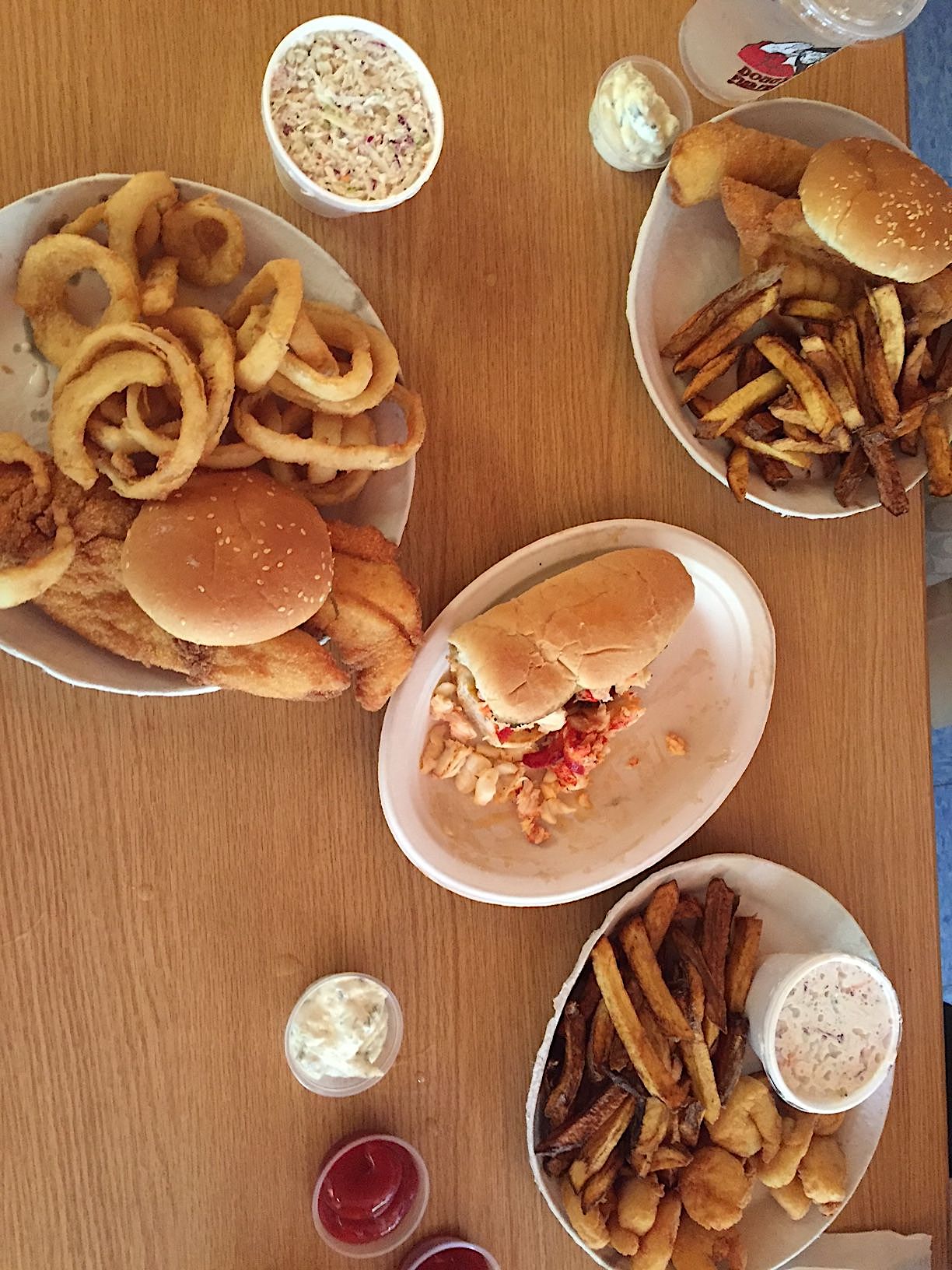 The
ice cream shakes ($3.95) are reason enough to come
with the kids, who will be agog at the railroad
train puffing its way across the perimeter of the
dining room, whose murals tell the story of the
region with folkloric charm.
The
ice cream shakes ($3.95) are reason enough to come
with the kids, who will be agog at the railroad
train puffing its way across the perimeter of the
dining room, whose murals tell the story of the
region with folkloric charm.
Similar to Skaneateles only for its location on one of the Finger Lakes is Aurora, established in 1795 after having been burned to the ground during the Revolutionary War. The Indians called it “the village of constant dawn,” owing to the long, lingering soft morning light coming off Lake Cayuga; hence the name Aurora, named after the Roman goddess of dawn.
As much as anywhere in America, like Winston-Salem, North Carolina, and Shaker villages like those Mount Lebanon in Lebanon, NY, Aurora is a living museum with a charming walking tour that begins with the beautiful Aurora Inn (below), one of a trio of buildings dating to the 1830s. My wife and I stayed there for a night and could have stayed for many more in the gracious, wall-papered room—one of ten—with marbled bath, fireplace and all modern amenities. Sitting on the porch, rocking in a wooden chair, watching the sun come up or down is one of the quiet, and great, pleasures of Aurora.
 An
option is the E.B. Morgan House (1858), with its
stone masonry, etched glass front doors and
skylight, library and seven original marble
fireplaces; now with seven rooms and a collection
of modern art; or the new reconstruction of the Rowland
House, a Queen Anne mansion with a
wrap-around porch and verandah, a Grecian temple,
and a two-story boathouse with docks. The Colonial
Revival-style Wallcourt Hall (1909), formerly
part of Wells
College, was maintained for decades by a proud
alumna named Ann Goldsmith, though it fell into
decrepitude and was purchased by the Inns of
Aurora in 2104 and renovated to become a 17-room
hotel.
An
option is the E.B. Morgan House (1858), with its
stone masonry, etched glass front doors and
skylight, library and seven original marble
fireplaces; now with seven rooms and a collection
of modern art; or the new reconstruction of the Rowland
House, a Queen Anne mansion with a
wrap-around porch and verandah, a Grecian temple,
and a two-story boathouse with docks. The Colonial
Revival-style Wallcourt Hall (1909), formerly
part of Wells
College, was maintained for decades by a proud
alumna named Ann Goldsmith, though it fell into
decrepitude and was purchased by the Inns of
Aurora in 2104 and renovated to become a 17-room
hotel.
Patrick Higgins is executive chef for all the inns
here, providing delightful breakfasts, lunch and
dinner, with all fare made 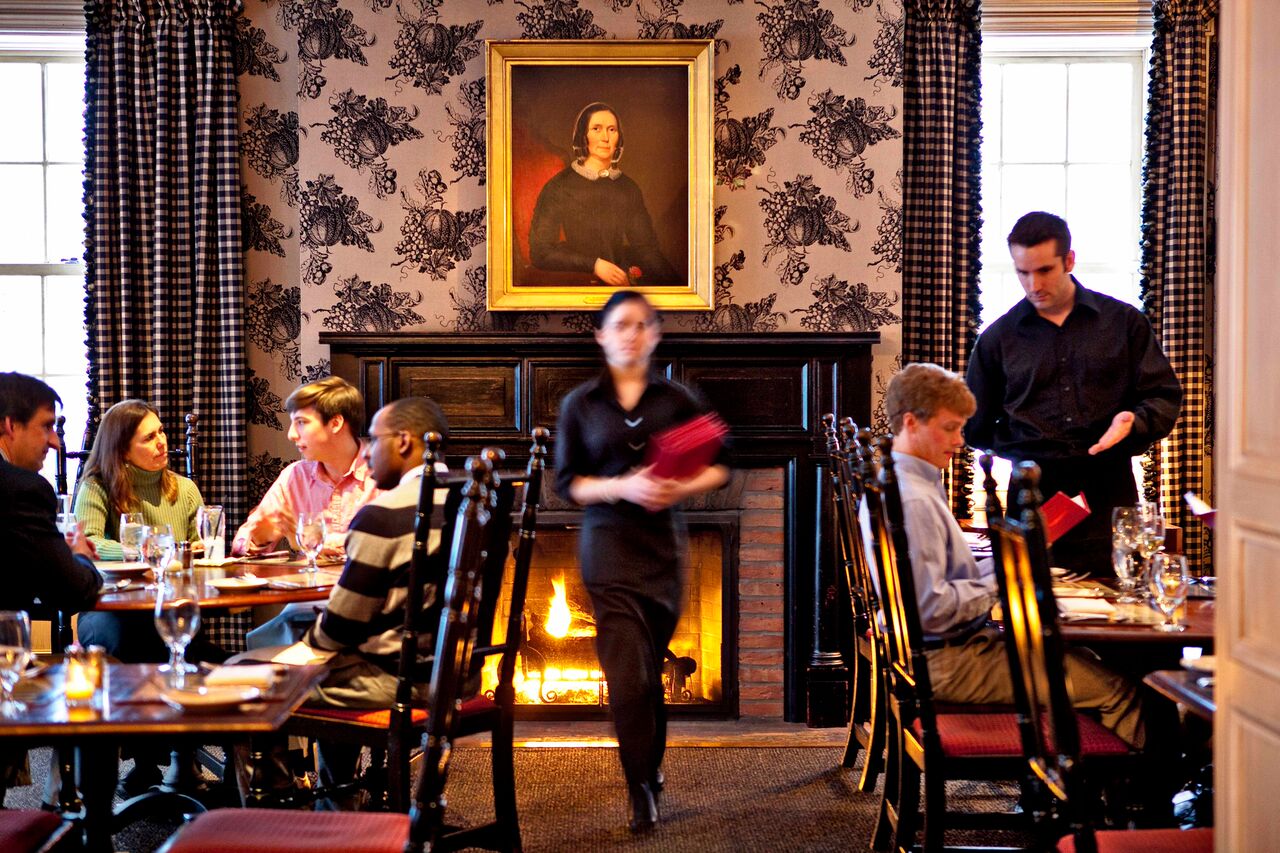 on the premises, using
the bountiful provender of local farmers. At our
dinner at the Aurora
Inn Dining Room (right), we enjoyed
an excellent appetizer of pork belly with peaches,
fennel and preserved ramps ($11), and a board of
housemade charcuterie ($12-$15); for the main
course country fried chicken with whipped potatoes
($24), finishing with three terrific desserts (all
$9)—apricot crisp with oatmeal streusel and
vanilla ice cream; chocolate mousse torte; and
coconut cake.
on the premises, using
the bountiful provender of local farmers. At our
dinner at the Aurora
Inn Dining Room (right), we enjoyed
an excellent appetizer of pork belly with peaches,
fennel and preserved ramps ($11), and a board of
housemade charcuterie ($12-$15); for the main
course country fried chicken with whipped potatoes
($24), finishing with three terrific desserts (all
$9)—apricot crisp with oatmeal streusel and
vanilla ice cream; chocolate mousse torte; and
coconut cake.
Other historic building on the Aurora tour include
the Cayuga Lake National Bank (1840), done in an
Italianate limestone style; the Greek Revival
Taylor House (1838), which became part of Wells
College; the Fargo Bar & Grill (1834), popular
with the locals; and Phelps House (1800; below), now
home to Jane Morgan’s Little House, a clothing
boutique that has grown into Jane Morgan’s Bigger
Little House in another building. 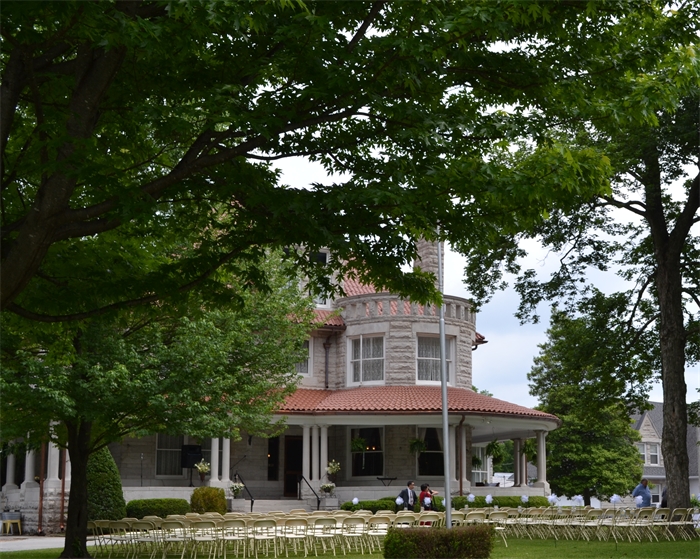 Many were once part of Wells
College, founded for women in 1868, now
co-ed.
Many were once part of Wells
College, founded for women in 1868, now
co-ed.
The fact that all of these properties are as well maintained, trim and decorated with truly fine art as they’ve ever been is due to an enduring love affair a woman named Pleasant Rowland had for the village and Wells College, which she’d attended. Rowland went on to become the creator of the fabulously successful American Girl brand (sold to Mattel for $700 million in 1998), and many of her philanthropic efforts have gone into preserving this very special, very beautiful, very quiet village on Cayuga Lake, commemorated in Cornell University’s alma mater song.
As contemporary as the services are in the inns here, walking outside on the lawns, down to the lake or along Main Street easily evokes what small town American was like at the turn of the century, when horses meant more than automobiles, all food was seasonal, and you could see shooting stars cross the blue-black sky.
By John Mariani
100 East 19th Street
212-243-4020

For those unfamiliar with
the NYC dining scene in 1985 it would be
difficult to assess what a  break-through
restaurant the original Union Square Café was,
all without fanfare. For while there were
plenty of wonderful restaurants then of every
stripe, none had quite the ambiance and charm of
a place that St. Louis-born owner Danny Meyer (right)
chose to call a café, signifying right away that
this would be a casual place, a neighborhood
spot in a place without many places to eat, but
with really good food, more or less Italian.
break-through
restaurant the original Union Square Café was,
all without fanfare. For while there were
plenty of wonderful restaurants then of every
stripe, none had quite the ambiance and charm of
a place that St. Louis-born owner Danny Meyer (right)
chose to call a café, signifying right away that
this would be a casual place, a neighborhood
spot in a place without many places to eat, but
with really good food, more or less Italian.
Actually, it took three years
for USC to garner the kind of kudos it received
when Chef Michael Romano took over the kitchen,
including three stars from the NY Times
and national accolades, even though the
ever-puzzling Michelin
Guide has never seen fit to award it a
single star.
The food went from very good to
really, really good after Romano’s arrival, but it
was a combination of warm hospitality and
professionalism that caused USC to become a totem
for what an American restaurant should be in the
late 20th century.
From the moment a host picked up the phone
when you called to the final goodnight, you felt
as well taken care of as if you were part of an
extended family.
Meyer put it best when he told Esquire magazine,
“There are a finite number of things that any
restaurant can serve at a high level of quality.
Understanding how to edit the classic with the new
is a really important thing. 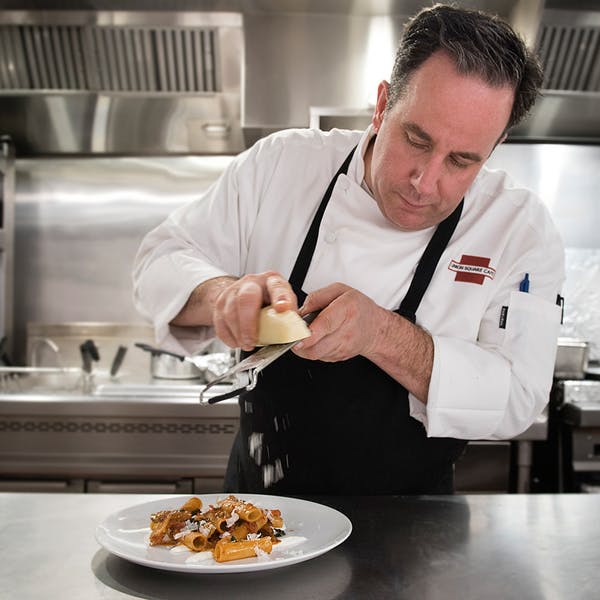 And we're
going to make mistakes. But when we make mistakes
we really care.”
And we're
going to make mistakes. But when we make mistakes
we really care.”
Meyer went on to open
bigger, more expansive restaurants like Gramercy
Tavern and The Modern, as well as a slew of Shake
Shacks around the country. But the
closing of USC—owing to an exorbitant rent
hike—sent shock waves through the food media, and
regulars wept at the thought of their favorite
restaurant not being there for them.
Though it took a while, Meyer
and his Union Square Hospitality Group re-located
USC, now on East 19th Street, to larger quarters,
complete with a fine long bar, a very loud
downstairs dining room (below, right), a quieter
mezzanine floor (below,
left), and much the same beloved artwork
that so distinguished the original premises.
Chef
Carmen Quagliata's menu does not diverge from
the evergreen style USC has always proffered,
and while that may be a safe course to follow,
it is one few of USC’s idolaters would ever want
to change. The menu is of a sensible size and
the 44-page wine list is one of the best in
breadth and depth in the country; given its
size, prices will range from very reasonable to
high. 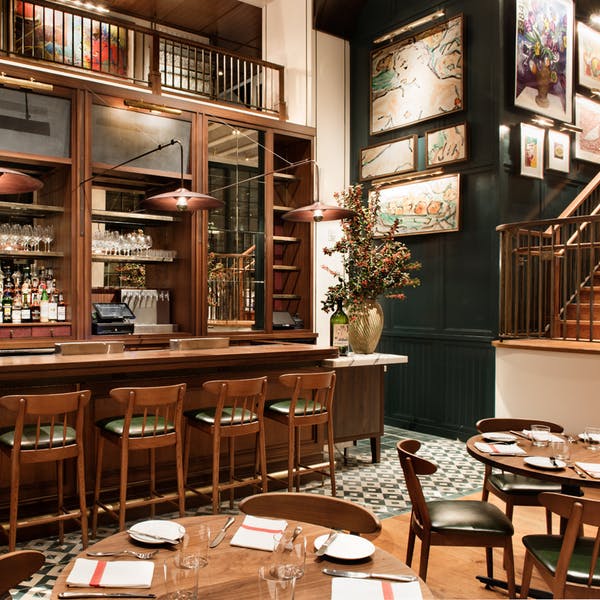 The wine director,
Jason Wagner, and six sommeliers will graciously
advise you. Half bottles are legion.
The wine director,
Jason Wagner, and six sommeliers will graciously
advise you. Half bottles are legion.
The service continues at that remarkable
high level of amiability and knowledge that has
influenced restaurants throughout the industry. After
one visit, you’ll feel you know your servers,
trust them completely and will want to tell
friends about them.
On two recent visits I found
the timing of the meal and service of the wine
impeccable. On one occasion a pasta dish came out
tepid and was whisked away and a fresh one brought
back within minutes. The sommeliers are happy to
chat with you without ever breaking into the
turgidity of Winespeak.
There is
a selection of oysters nightly ($4 each), and
seven appetizers (plus specials) that always
include a crudo
like lustrous Spanish mackerel with artichoke,
Castelvetrano olives and a bite of chili ($17). My
favorite starter was a marvelous, quivering
cauliflower sformato
with a romanesco sauce and rich black truffle fonduta
($21), and though fried calamari with anchovy mayo
($19) were very good in flavor and crispiness, I
wondered why such a ubiquitous dish is on the
menu.
Indeed, the dish has already been replaced by a
fritto misto of
calamari, artichokes, scallops and skate. A
bowl of cornmeal polenta with crescenza cheese,
maitake mushrooms and pesto
($13) didn’t quite measure up to be a course on
its own.
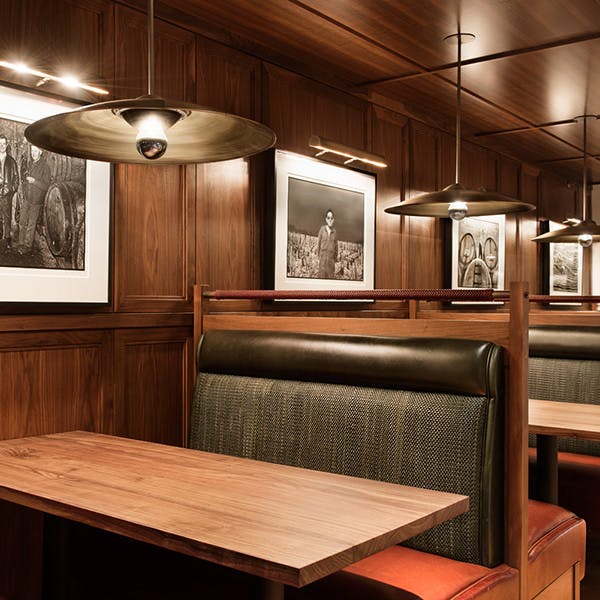 There are six pastas,
including ricotta gnocchi with a light
tomato-basil passatina
and good dousing of pecorino romano ($18), and
delicious candele
pasta dumplings with carrots, chilies, scallion, pancetta
and a dollop of
thick Greek yogurt ($23), though now made
with rigatoni. A good
test of a kitchen is its broth, here the bath for
fat housemade tortelloni ($19), and Quagliata’s
is excellent on all counts, with a melding of
vegetable flavors like Swiss chard and a soffrito
(an Italian roux) to give it even more of a boost.
There are six pastas,
including ricotta gnocchi with a light
tomato-basil passatina
and good dousing of pecorino romano ($18), and
delicious candele
pasta dumplings with carrots, chilies, scallion, pancetta
and a dollop of
thick Greek yogurt ($23), though now made
with rigatoni. A good
test of a kitchen is its broth, here the bath for
fat housemade tortelloni ($19), and Quagliata’s
is excellent on all counts, with a melding of
vegetable flavors like Swiss chard and a soffrito
(an Italian roux) to give it even more of a boost.
Fans of the great USC burger
($27) will be relieved to find it still in its
glory, made with Beecher’s Flagship Cheddar and
thick bacon on a brioche roll with first-rate
French fries.
I don’t recall if the spiced chicken with a
white sweet potato puree cooked à la plancha
with baby onions ($31) had been on the old menu,
but I plead with Quagliata never to remove it from
the current one.
The spicing is assertive and complex, the
skin crisp, the meat moist; this is as fine a
chicken dish as can be found in NYC.
Pan-roasted squab with ramp
polenta and rhubarb ($43), braised lamb shank with
salsa verde
and roasted potatoes ($46), and perfectly roasted
rack of juicy pork with shell 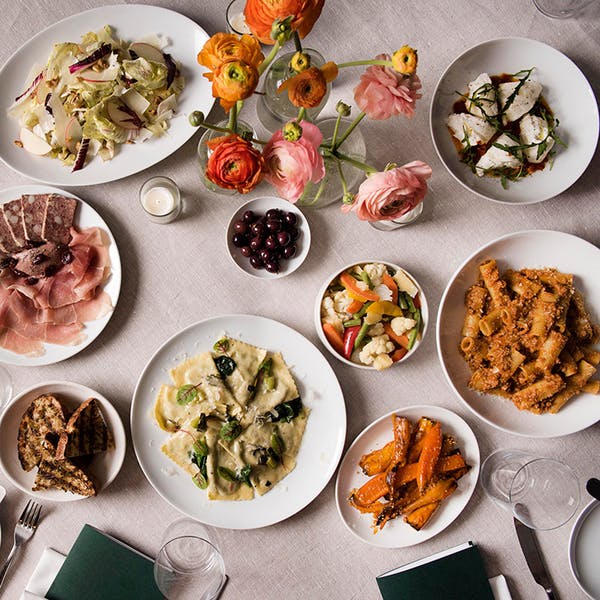 beans,
kale, and a fennel-apple mostarda
($39) all won favor, but a butter-roasted monkfish
in a too-mild mushroom broth with turnips and
cabbage ($38) needed spark.
beans,
kale, and a fennel-apple mostarda
($39) all won favor, but a butter-roasted monkfish
in a too-mild mushroom broth with turnips and
cabbage ($38) needed spark.
Pastry
chef Daniel Alvarez’s desserts ($13) all fit the
curve at USC: solid renderings of a homey
chocolate pecan tart with maple-bourbon jam and
coconut ice cream; buttermilk panna cotta with
citrus, oat crumble, olive oil and Clementine
sorbet; a rhubarb sundae with frozen yogurt, puff
grains and whipped cream; and deeply satisfying
espresso chocolate cake with an espresso ganache
and caramel.
There is also a selection of fine cheeses
($7 each). By the way, the bread here
is some of the best in NYC.
The immediate success of the
new USC was pretty much guaranteed, and it can be
difficult to get a table on short notice, though
Mondays and Tuesday are not so tough, and, I found
upon leaving around nine-thirty, people were
coming in without a rez and being seated promptly. Great
for après cinema.
Welcome back, USC. You were
missed and now you’re better than ever.
Open for lunch Mon.-Fri; Brunch Sat. & Sun; Dinner nightly.
❖❖❖
WHAT I'M DRINKING NOW
By John Mariani

"To take wine into our mouths is to savor a droplet of the river of human history."-- Clifton Fadiman
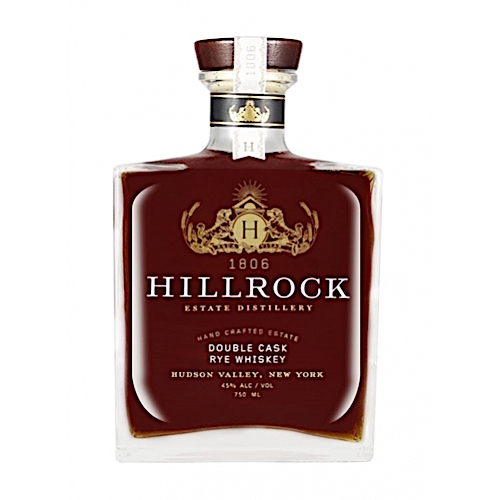 HILLROCK
ESTATE DISTILLERY DOUBLE CASK RYE SAUTERNES
FINISH ($90)—This is one of the most
impressive ryes I’ve tasted in the past year,
amazingly complex, just dry enough, with a woodsy
quality, no burn at the back, and a very rich
layer of spice. And it comes from the Hudson
Valley of New York, made from rye grown on its own
estate—something very unusual in spirits
production—and Hillrock makes several iterations,
this one finished in Sauternes barrels and all
presented in handsome bottles. 45%
alcohol.
HILLROCK
ESTATE DISTILLERY DOUBLE CASK RYE SAUTERNES
FINISH ($90)—This is one of the most
impressive ryes I’ve tasted in the past year,
amazingly complex, just dry enough, with a woodsy
quality, no burn at the back, and a very rich
layer of spice. And it comes from the Hudson
Valley of New York, made from rye grown on its own
estate—something very unusual in spirits
production—and Hillrock makes several iterations,
this one finished in Sauternes barrels and all
presented in handsome bottles. 45%
alcohol.
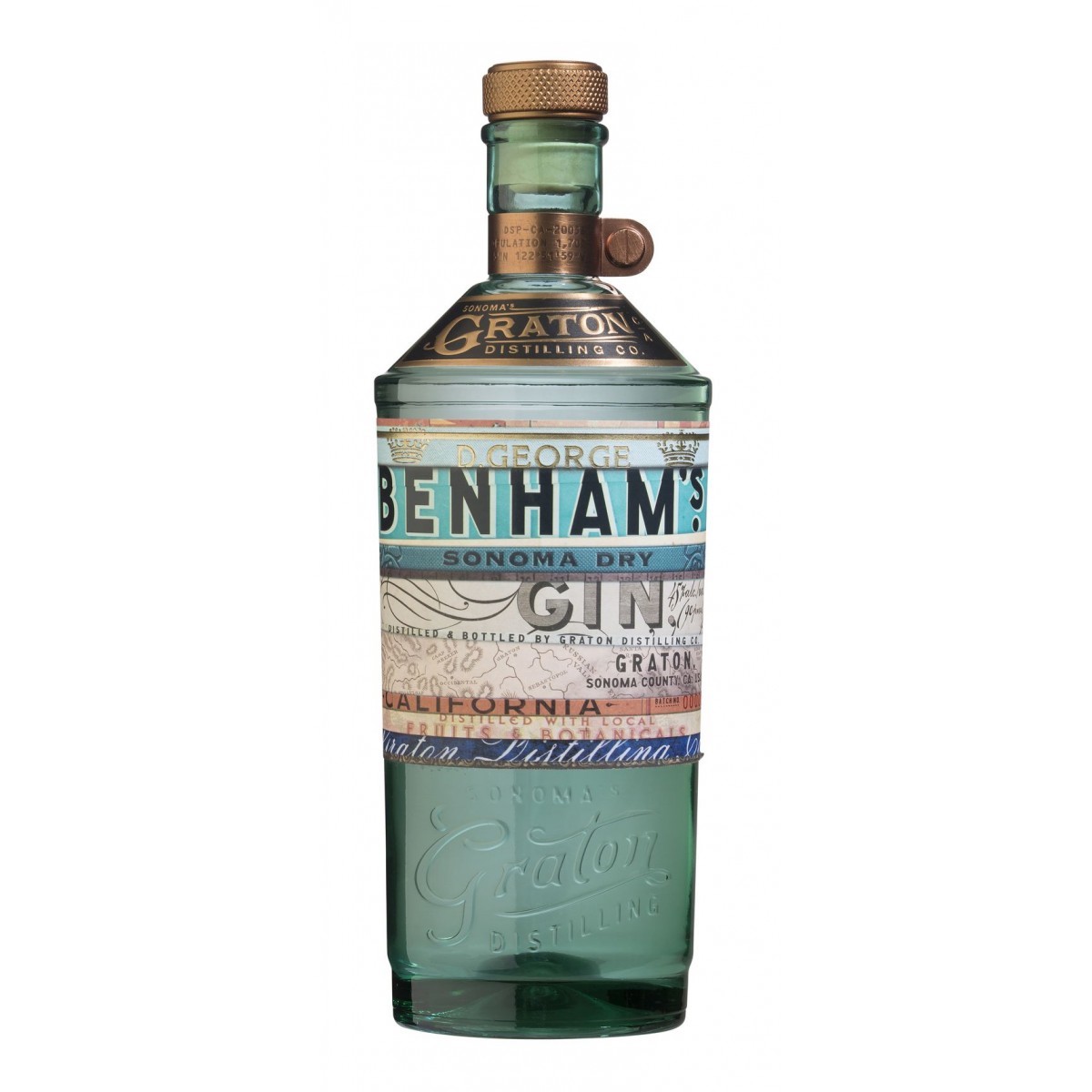 GEORGE BENHAM’S GIN ($40)—For
its beautiful label alone, you might pick this
right off the shelf, and the back of the label
revels in California hype. But the
traditional botanicals used, from Sonoma’s “funky
little town of Graton,” provide a lot more flavors
than you’d find in a wide range of high volume
gins that seem to taste like little more than
vodka. It’s definitely peppery and would make an
excellent Martini or Gibson. On the
rocks, you could enjoy it with smoked salmon.
GEORGE BENHAM’S GIN ($40)—For
its beautiful label alone, you might pick this
right off the shelf, and the back of the label
revels in California hype. But the
traditional botanicals used, from Sonoma’s “funky
little town of Graton,” provide a lot more flavors
than you’d find in a wide range of high volume
gins that seem to taste like little more than
vodka. It’s definitely peppery and would make an
excellent Martini or Gibson. On the
rocks, you could enjoy it with smoked salmon.
MONTANYA
RUM
EXCLUSIVA ($59)—In Anguilla recently I
found a bar with more than 200 rums, including
some American-made, which proves that good rums
can be produced in wide variety. This 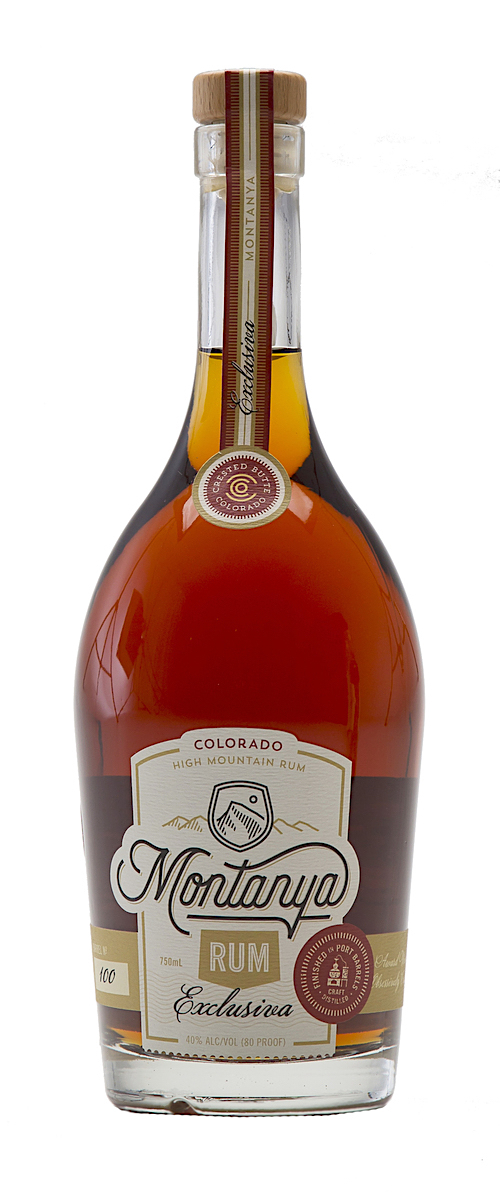 one, from Crested Butte, Colorado,
with sugar cane culled from Louisiana, is a fine,
limited-release, tough-to-find example of modern
rum making, barrel-aged for two years in American
white oak then another six in French oak. Lots of
cinnamon, a little like Dr Pepper, and it makes an
excellent mixer for a Daiquiri or Cuba Libré.
one, from Crested Butte, Colorado,
with sugar cane culled from Louisiana, is a fine,
limited-release, tough-to-find example of modern
rum making, barrel-aged for two years in American
white oak then another six in French oak. Lots of
cinnamon, a little like Dr Pepper, and it makes an
excellent mixer for a Daiquiri or Cuba Libré.
LE SERRE NUOVE DELL’ORNELLAIA 2103 ($55-$80)—This is the baby sister of the great Ornellaia of Bolgheri, with grapes coming primarily from younger vineyards, a blend of Merlot, Cabernet Sauvignon, Cabernet Franc and Petit Verdot—very Bordeaux-like rather than Tuscan—at 14.5% alcohol. It has a nice bite but it is not massive, an ideal wine for grilled meats and poultry.
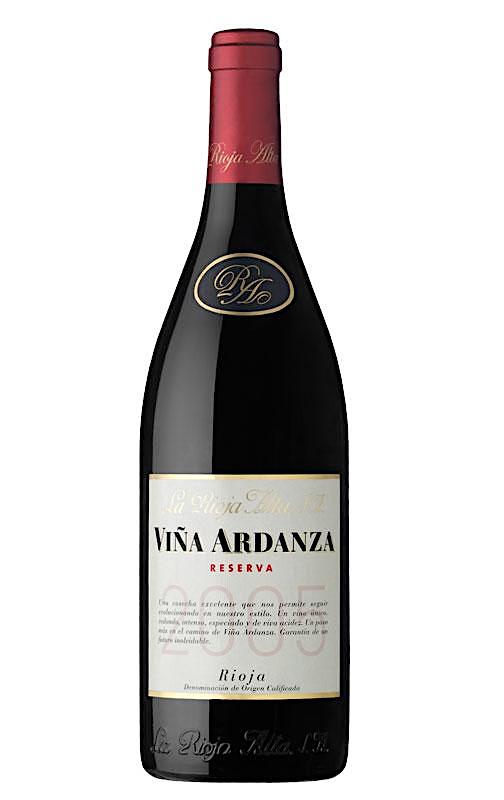 VIÑA
ARDANZA RESERVA 2008 ($25-$30)—I truly
believe I finally understood how impressive modern
Spanish winemaking could be when I tasted Viña
Ardanza for the first time, perhaps 20 years ago. A Rioja
Alta made from 20% Garnacha and the rest
Tempranillo, it is powerful and fruit-rich, but it
is not, as some fool noted in the wine press,
“jammy”—meant as a compliment. It is
in fact silky, velvety and has a brilliant long
finish that makes every sip and every glass a joy
with red meats, grilled rabbit, and stews. It also
proves, at 13.5% alcohol, you don’t have to go big
to be bold.
VIÑA
ARDANZA RESERVA 2008 ($25-$30)—I truly
believe I finally understood how impressive modern
Spanish winemaking could be when I tasted Viña
Ardanza for the first time, perhaps 20 years ago. A Rioja
Alta made from 20% Garnacha and the rest
Tempranillo, it is powerful and fruit-rich, but it
is not, as some fool noted in the wine press,
“jammy”—meant as a compliment. It is
in fact silky, velvety and has a brilliant long
finish that makes every sip and every glass a joy
with red meats, grilled rabbit, and stews. It also
proves, at 13.5% alcohol, you don’t have to go big
to be bold.
ASTER RIBERA DEL DUERO 2013 ($21)—The huge flavor of this Crianza, meaning it’s 100% Tempranillo aged for a year in oak and up to a year in bottle, is the character of the varietal, so it doesn’t need a great deal of age to reveal itself, even at just 14% alcohol. Owing to its price, it makes for an easy way to appreciate good Spanish wines without sticker shock.
AVIGNONESI VINO NOBILE DE MONTELPULCIANO 2012 ($28)—Not to be confused with Montepulciano d’Abruzzo, this is one of Tuscany’s fine wines that doesn’t quite get the attention it deserves, except from those cognoscenti who prefer it to a lot of self-described Super Tuscans out there. It shows more power than its 14% alcohol, and it can use a little more time in the bottle to knit its elements and soften its tannins. Many lesser Italian reds at twice the price don’t deliver the sheer satisfaction of Avognonesi.
PARADUXX
PROPRIETARY
NAPA VALLEY RED WINE ($48)—If you like a
big, chewy Napa red not sky-high in alcohol, I
think you’ll find this intense but wonderfully
smooth, a blend of 65% Cabernet Sauvignon with 30%
Zinfandel and 5% Merlot, persuasive proof that Zin
belongs in California blends. It
gives up a luscious fruit that tames the Cab, and
the Merlot brings it all into harmony.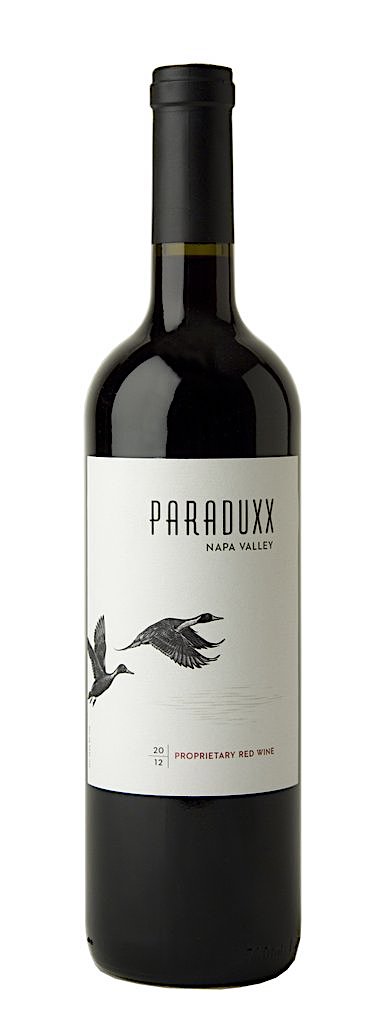
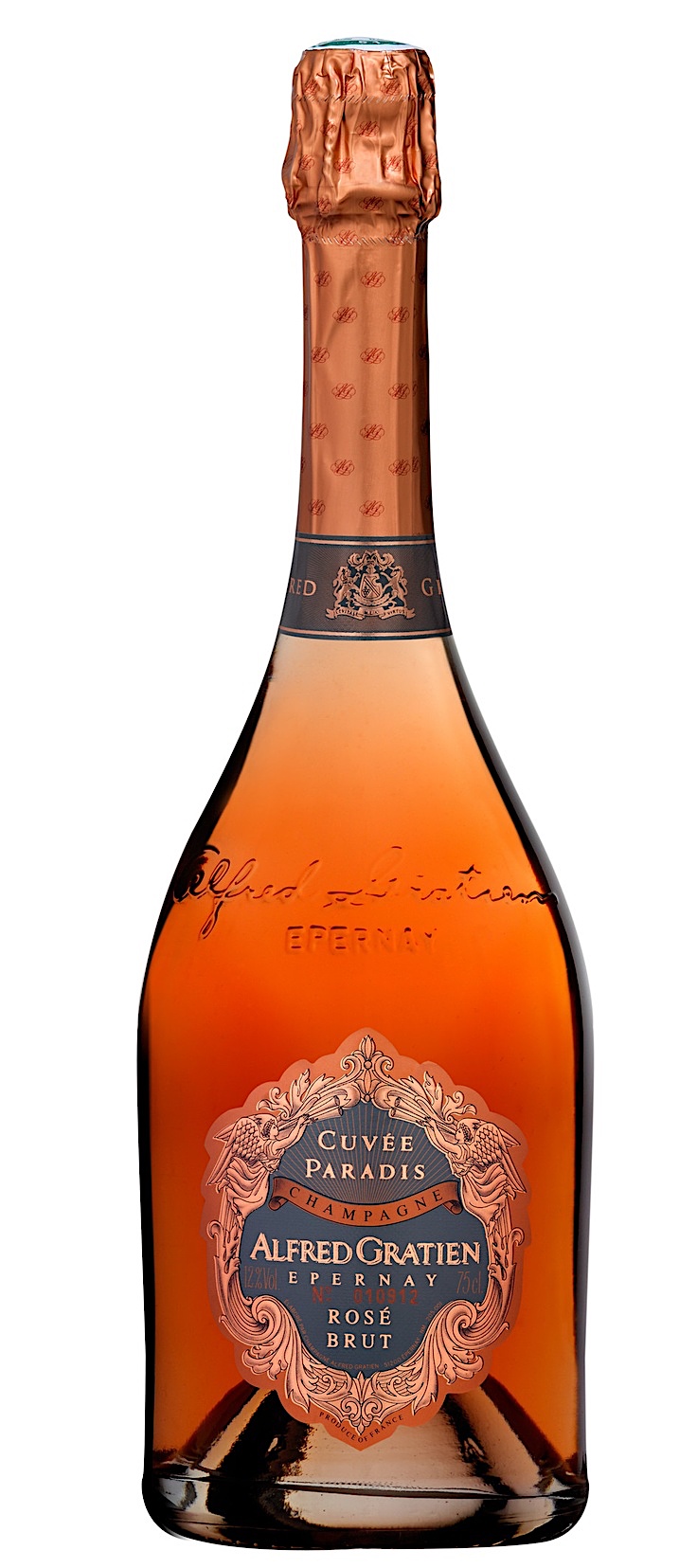 ALFRED GRATIEN CUVÉE PARADIS ROSÉ
BRUT ($135)—For those who find préstige
cuvées too deliberately dry and without sufficient
fruitiness, this splendid copper-colored rosé
provides elegant balance of fruit and acid with
nuances of flowers in the bouquet and finish. The
house has been in Épernay since 1864, and the
current winemaker, Nicolas Jaeger, is making
better Champagne than ever. The
bubbles are not too large, slow to rise, and the
creaminess of the Pinot Noir is charming.
ALFRED GRATIEN CUVÉE PARADIS ROSÉ
BRUT ($135)—For those who find préstige
cuvées too deliberately dry and without sufficient
fruitiness, this splendid copper-colored rosé
provides elegant balance of fruit and acid with
nuances of flowers in the bouquet and finish. The
house has been in Épernay since 1864, and the
current winemaker, Nicolas Jaeger, is making
better Champagne than ever. The
bubbles are not too large, slow to rise, and the
creaminess of the Pinot Noir is charming.
FERRARI BRUT ($23)—If you don’t go the expensive route of celebrating with Champagne, a wine like Ferrari 100% Chardonnay Brut is perfect for Mother’s Day and every summer holiday. Ferrari’s been at this a long time—since 1902—and it shows in the consistency of every bottle, with the apple-tang and floral aromas of cool weather Trentino. Ageing for at least 24 months gives it far more complexity than Prosecco.
CHÂTEAU DE SÉGUIN CUVÉE PRÉSTIGE 2013 ($15)—It may be faint praise to say this is a very nice Bordeaux, but this Supérieur category example is what you could drink twice a week with a wide variety of homecooked meals, and at a very reasonable price. It’s the kind of wine that is coming into the market now from Bordeaux that proves the region’s versatility without pretending to be more notable than it is dependable.
❖❖❖
THE BIG SURPRISE WAS THAT HE COULD READ

North Carolinian gun-toter Edgar Madison Welch (left), 28,
pleaded guilty to two weapons charges when he
brought at AR-15 rifle to "self-investigate"
a

"The question of where to have lunch when you’re summoned to jury duty is of grave importance: It may very well be the brightest spot in your day. Luckily, the courthouses in Manhattan happen to be in stone’s-throw proximity to some of the very best — not to mention most comforting — restaurants in the borough, smack dab on the border of Chinatown and Tribeca. Here are the very best spots to break for sustenance while fulfilling your civic duty.”-- "The Absolute Best Restaurants for Jury-Duty Lunch Breaks" By Hannah Goldfield, NY Magazine (3/20/17)
Any of John Mariani's books below may be ordered from amazon.com.
 The
Hound in Heaven (21st Century Lion Books)
is a novella, and for anyone who loves dogs,
Christmas, romance, inspiration, even the supernatural, I
hope you'll find this to be a treasured favorite.
The story concerns how, after a New England teacher,
his wife and their two daughters adopt a stray puppy found
in their barn in northern Maine, their lives seem full of
promise. But when tragedy strikes, their wonderful dog
Lazarus and the spirit of Christmas are the only things
that may bring his master back from the edge of
despair.
The
Hound in Heaven (21st Century Lion Books)
is a novella, and for anyone who loves dogs,
Christmas, romance, inspiration, even the supernatural, I
hope you'll find this to be a treasured favorite.
The story concerns how, after a New England teacher,
his wife and their two daughters adopt a stray puppy found
in their barn in northern Maine, their lives seem full of
promise. But when tragedy strikes, their wonderful dog
Lazarus and the spirit of Christmas are the only things
that may bring his master back from the edge of
despair. WATCH THE VIDEO!
“What a huge surprise turn this story took! I was completely stunned! I truly enjoyed this book and its message.” – Actress Ali MacGraw
“He had me at Page One. The amount of heart, human insight, soul searching, and deft literary strength that John Mariani pours into this airtight novella is vertigo-inducing. Perhaps ‘wow’ would be the best comment.” – James Dalessandro, author of Bohemian Heart and 1906.
“John Mariani’s Hound in Heaven starts with a well-painted portrayal of an American family, along with the requisite dog. A surprise event flips the action of the novel and captures us for a voyage leading to a hopeful and heart-warming message. A page turning, one sitting read, it’s the perfect antidote for the winter and promotion of holiday celebration.” – Ann Pearlman, author of The Christmas Cookie Club and A Gift for my Sister.
“John Mariani’s concise, achingly beautiful novella pulls a literary rabbit out of a hat – a mash-up of the cosmic and the intimate, the tragic and the heart-warming – a Christmas tale for all ages, and all faiths. Read it to your children, read it to yourself… but read it. Early and often. Highly recommended.” – Jay Bonansinga, New York Times bestselling author of Pinkerton’s War, The Sinking of The Eastland, and The Walking Dead: The Road To Woodbury.
“Amazing things happen when you open your heart to an animal. The Hound in Heaven delivers a powerful story of healing that is forged in the spiritual relationship between a man and his best friend. The book brings a message of hope that can enrich our images of family, love, and loss.” – Dr. Barbara Royal, author of The Royal Treatment.
 |
The Encyclopedia of American Food and Drink by John F. Mariani (Bloomsbury USA, $35) Modesty forbids me to praise my own book, but let me proudly say that it is an extensive revision of the 4th edition that appeared more than a decade ago, before locavores, molecular cuisine, modernist cuisine, the Food Network and so much more, now included. Word origins have been completely updated, as have per capita consumption and production stats. Most important, for the first time since publication in the 1980s, the book includes more than 100 biographies of Americans who have changed the way we cook, eat and drink -- from Fannie Farmer and Julia Child to Robert Mondavi and Thomas Keller. "This book is amazing! It has entries for everything from `abalone' to `zwieback,' plus more than 500 recipes for classic American dishes and drinks."--Devra First, The Boston Globe. "Much needed in any kitchen library."--Bon Appetit. |
"Equal parts
history, sociology, gastronomy, and just
plain fun, How Italian Food Conquered the
World tells the captivating and delicious
story of the (let's face it) everybody's
favorite cuisine with clarity, verve and
more than one surprise."--Colman Andrews,
editorial director of The Daily
Meal.com. "A fantastic and fascinating
read, covering everything from the influence
of Venice's spice trade to the impact of
Italian immigrants in America and the
evolution of alta cucina. This book will
serve as a terrific resource to anyone
interested in the real story of Italian
food."--Mary Ann Esposito, host of PBS-TV's
Ciao
Italia. "John Mariani has written the
definitive history of how Italians won their
way into our hearts, minds, and
stomachs. It's a story of pleasure over
pomp and taste over technique."--Danny Meyer,
owner of NYC restaurants Union Square
Cafe, The Modern, and Maialino.
|
 |
 |
 |
 |
 |
 |
 |
 |
 Everett Potter's Travel Report:
Everett Potter's Travel Report: 
 Eating Las Vegas
JOHN CURTAS has been covering the Las Vegas
food and restaurant scene since 1995. He is
the co-author of EATING LAS VEGAS – The 50
Essential Restaurants (as well as
the author of the Eating Las Vegas web site: www.eatinglasvegas.
He can also be seen every Friday morning as
the “resident foodie” for Wake Up With the
Wagners on KSNV TV (NBC) Channel 3 in
Las Vegas.
Eating Las Vegas
JOHN CURTAS has been covering the Las Vegas
food and restaurant scene since 1995. He is
the co-author of EATING LAS VEGAS – The 50
Essential Restaurants (as well as
the author of the Eating Las Vegas web site: www.eatinglasvegas.
He can also be seen every Friday morning as
the “resident foodie” for Wake Up With the
Wagners on KSNV TV (NBC) Channel 3 in
Las Vegas.

MARIANI'S VIRTUAL GOURMET
NEWSLETTER is published weekly. Editor/Publisher: John
Mariani.
Editor: Walter Bagley. Contributing Writers: Christopher Mariani,
Robert Mariani, Misha Mariani, John A. Curtas, Geoff Kalish, Mort
Hochstein, and
Brian Freedman. Contributing Photographers: Galina
Dargery. Technical Advisor: Gerry McLoughlin.
To un-subscribe from this newsletter,click here.
© copyright John Mariani 2017

